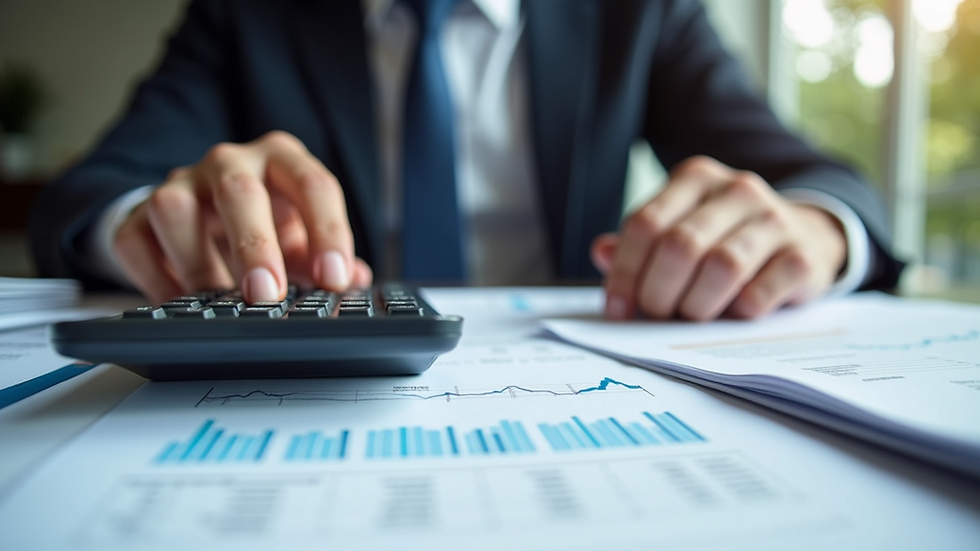Understanding VAT Returns for SMEs
- iuliapotinga
- Aug 19
- 4 min read
Updated: Oct 9
Value Added Tax (VAT) can be a complex topic, especially for small and medium-sized enterprises (SMEs). Many business owners find themselves overwhelmed by the rules and regulations surrounding VAT returns. However, understanding VAT returns is crucial for compliance and financial health. In this post, we will break down the essentials of VAT returns, making it easier for SMEs to navigate this important aspect of their business.
VAT is a consumption tax that is applied to goods and services. It is charged at each stage of the supply chain, from production to sale. For SMEs, managing VAT can seem daunting, but with the right knowledge, it can be a straightforward process.
Let’s explore the key components of VAT returns, including what they are, how to prepare them, and common pitfalls to avoid.
What is a VAT Return?
A VAT return is a document that businesses submit to HMRC, detailing the amount of VAT they have charged and the amount they have paid on their purchases. This return is typically submitted quarterly or annually, depending on the business's turnover and local regulations.
The VAT return includes:
Sales VAT: The VAT collected from customers on sales.
Purchase VAT: The VAT paid on business expenses and purchases.
Net VAT: The difference between sales VAT and purchase VAT. If sales VAT exceeds purchase VAT, the business must pay the difference to the tax authority. If purchase VAT exceeds sales VAT, the business can claim a refund.
Understanding these components is essential for accurate reporting and compliance.
Why are VAT Returns Important for SMEs?
VAT returns are not just a bureaucratic requirement; they play a vital role in the financial health of SME businesses. Here are a few reasons why they matter:
Legal Compliance: Submitting accurate VAT returns is a legal obligation. Failing to do so can result in penalties and fines.
Cash Flow Management: Understanding VAT can help SMEs manage their cash flow better. Knowing when to expect VAT payments or refunds can aid in financial planning.
Business Insights: VAT returns can provide valuable insights into sales trends and business performance. Analyzing VAT data can help SMEs make informed decisions.
Reputation: Timely and accurate VAT submissions enhance a business's reputation with tax authorities and can foster trust with customers and suppliers.
How to Prepare a VAT Return
Preparing a VAT return may seem intimidating, but breaking it down into manageable steps can simplify the process. Here’s a step-by-step guide:
Step 1: Gather Your Records
Start by collecting all relevant financial records for the reporting period. This includes:
Sales invoices
Purchase invoices
Bank statements
Receipts for business expenses
Having organized records will make the process smoother.
Step 2: Calculate Sales VAT
Next, calculate the total VAT collected from sales. This is done by reviewing all sales invoices issued during the reporting period.
For example, if you sold goods worth £10,000 and charged a VAT rate of 20%, your sales VAT would be:
Sales VAT = £10,000 times 0.20 = 2,000
Step 3: Calculate Purchase VAT
Now, calculate the total VAT paid on purchases. Review all purchase invoices and receipts to determine the VAT amount paid.
For instance, if you purchased supplies worth £5,000 and paid a VAT rate of 20%, your purchase VAT would be:
Purchase VAT = £5,000 times 0.20 = 1,000
Step 4: Determine Net VAT
Subtract the purchase VAT from the sales VAT to find the net VAT amount.
Net VAT = 2,000 - 1,000 = 1,000
If the result is positive, you owe that amount to the tax authority. If it is negative, you can claim a refund.
Step 5: Complete the VAT Return Form
Fill out the VAT return form provided by HMRC. Ensure that all figures are accurate and match your calculations.
Step 6: Submit the Return
Finally, submit your VAT return by the deadline. This can often be done online, making the process more convenient.
Common Pitfalls to Avoid
While preparing VAT returns, SMEs often encounter common mistakes. Here are some pitfalls to watch out for:
Inaccurate Record Keeping: Failing to keep accurate records can lead to errors in VAT calculations. Always ensure that your records are up to date and organised.
Missing Deadlines: Late submissions can result in penalties. Set reminders for VAT return deadlines to avoid this issue.
Not Claiming All Deductions: SMEs may overlook eligible VAT deductions on business expenses. Review all purchases carefully to ensure you claim everything you are entitled to.
Confusing VAT Rates: Different goods and services may have different VAT rates. Make sure you are applying the correct rate to each item.
Neglecting to Review Returns: Always double-check your VAT return before submission. Small errors can lead to significant issues down the line.
The Role of Technology in VAT Returns
In today’s digital age, technology can significantly ease the burden of preparing VAT returns. Here are some tools and software that can help SMEs:
Accounting Software: Programs like QuickBooks or Xero can automate VAT calculations and help keep records organized.
VAT Compliance Tools: These tools can assist in ensuring that your VAT returns comply with local regulations.
By leveraging technology, SMEs can save time and reduce the risk of errors.
Seeking Professional Help
While many SMEs can manage their VAT returns independently, some may benefit from professional assistance. Hiring a bookkeeper can provide several advantages:
Expertise: Professionals have in-depth knowledge of VAT regulations and can ensure compliance.
Time-Saving: Outsourcing VAT returns allows business owners to focus on running their business rather than getting bogged down in paperwork.
Strategic Advice: An accountant can offer insights on how to optimize VAT management and improve cash flow.
If you are unsure about handling VAT returns, consider consulting a professional.
Final Thoughts
Understanding VAT returns is essential for the success of SMEs. By grasping the basics, preparing accurately, and avoiding common pitfalls, business owners can navigate this complex area with confidence.
Remember, staying organised and informed is key. Whether you choose to manage VAT returns yourself or seek professional help, being proactive will lead to better financial health for your business.

With the right approach, VAT returns can become a manageable part of your business operations, allowing you to focus on what you do best—growing your business.




Comments